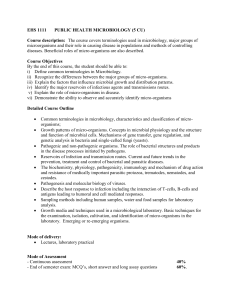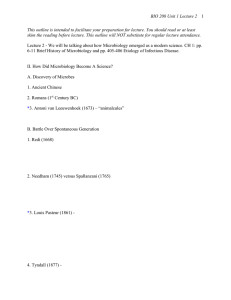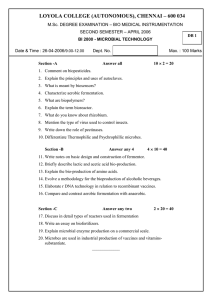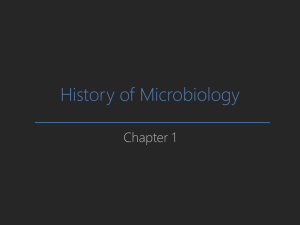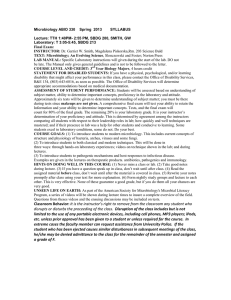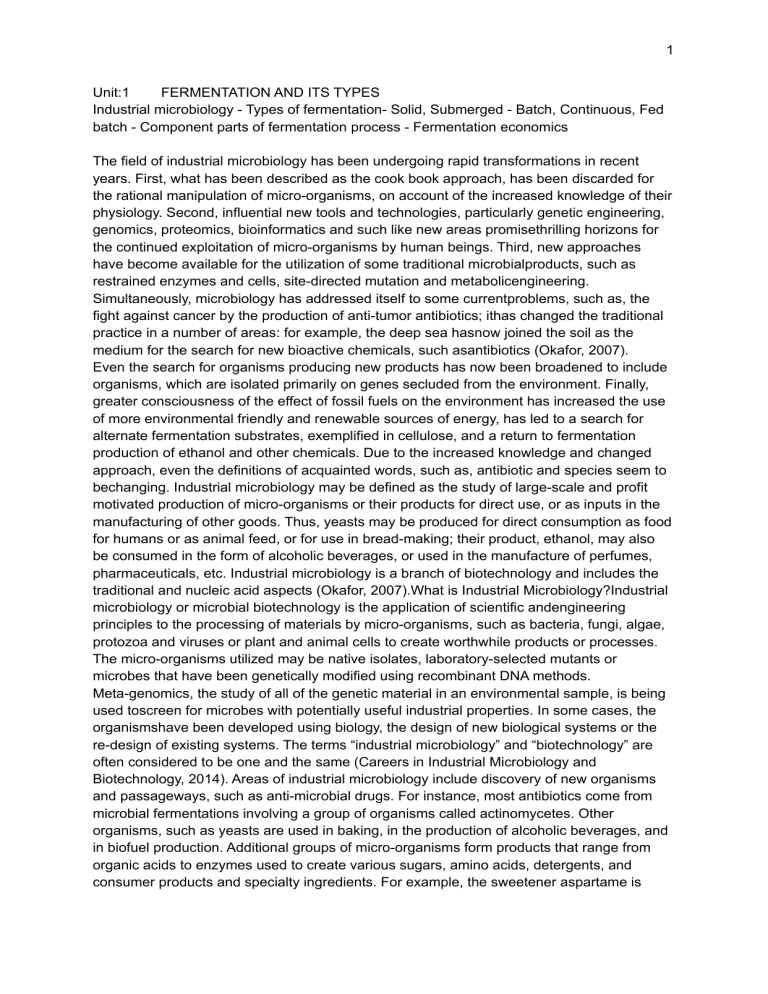
1 Unit:1 FERMENTATION AND ITS TYPES Industrial microbiology - Types of fermentation- Solid, Submerged - Batch, Continuous, Fed batch - Component parts of fermentation process - Fermentation economics The field of industrial microbiology has been undergoing rapid transformations in recent years. First, what has been described as the cook book approach, has been discarded for the rational manipulation of micro-organisms, on account of the increased knowledge of their physiology. Second, influential new tools and technologies, particularly genetic engineering, genomics, proteomics, bioinformatics and such like new areas promisethrilling horizons for the continued exploitation of micro-organisms by human beings. Third, new approaches have become available for the utilization of some traditional microbialproducts, such as restrained enzymes and cells, site-directed mutation and metabolicengineering. Simultaneously, microbiology has addressed itself to some currentproblems, such as, the fight against cancer by the production of anti-tumor antibiotics; ithas changed the traditional practice in a number of areas: for example, the deep sea hasnow joined the soil as the medium for the search for new bioactive chemicals, such asantibiotics (Okafor, 2007). Even the search for organisms producing new products has now been broadened to include organisms, which are isolated primarily on genes secluded from the environment. Finally, greater consciousness of the effect of fossil fuels on the environment has increased the use of more environmental friendly and renewable sources of energy, has led to a search for alternate fermentation substrates, exemplified in cellulose, and a return to fermentation production of ethanol and other chemicals. Due to the increased knowledge and changed approach, even the definitions of acquainted words, such as, antibiotic and species seem to bechanging. Industrial microbiology may be defined as the study of large-scale and profit motivated production of micro-organisms or their products for direct use, or as inputs in the manufacturing of other goods. Thus, yeasts may be produced for direct consumption as food for humans or as animal feed, or for use in bread-making; their product, ethanol, may also be consumed in the form of alcoholic beverages, or used in the manufacture of perfumes, pharmaceuticals, etc. Industrial microbiology is a branch of biotechnology and includes the traditional and nucleic acid aspects (Okafor, 2007).What is Industrial Microbiology?Industrial microbiology or microbial biotechnology is the application of scientific andengineering principles to the processing of materials by micro-organisms, such as bacteria, fungi, algae, protozoa and viruses or plant and animal cells to create worthwhile products or processes. The micro-organisms utilized may be native isolates, laboratory-selected mutants or microbes that have been genetically modified using recombinant DNA methods. Meta-genomics, the study of all of the genetic material in an environmental sample, is being used toscreen for microbes with potentially useful industrial properties. In some cases, the organismshave been developed using biology, the design of new biological systems or the re-design of existing systems. The terms “industrial microbiology” and “biotechnology” are often considered to be one and the same (Careers in Industrial Microbiology and Biotechnology, 2014). Areas of industrial microbiology include discovery of new organisms and passageways, such as anti-microbial drugs. For instance, most antibiotics come from microbial fermentations involving a group of organisms called actinomycetes. Other organisms, such as yeasts are used in baking, in the production of alcoholic beverages, and in biofuel production. Additional groups of micro-organisms form products that range from organic acids to enzymes used to create various sugars, amino acids, detergents, and consumer products and specialty ingredients. For example, the sweetener aspartame is 2 derived from microbially produced amino acids. Industrial microbiologists may also be responsible for the bioremediation of air, soil, and water contamination. Industrial microbiologists may also deal with products associated with the food, dairy, and consumer products industries, along with the prevention or deterioration of processed or manufactured goods, and with waste disposal systems. Quality assurance for the food, pharmaceutical, and chemical industries is a large area, along with the health of animals used in testing products (Careers in Industrial Microbiology and Biotechnology, 2014). History of Industrial MicrobiologyThe practise of industrial microbiology has its roots deep in ancient times. Long before their discovery, micro-organisms were exploited to serve the needs and requirements of humans, for example to preserve milk, fruits, and vegetables, and to improve the quality oflife by producing beverages, cheeses, bread, pickled foods, and vinegar. The use of yeasts dates back to the ancient days. The oldest fermentation know-how, the conversion of sugar to alcohol by yeasts was used to make beer in Sumeria and Babylonia as early as 7000 B.C. By 4000 B.C., the Egyptians had discovered that carbon dioxide was produced by the action of brewer’s yeast could leaven bread. Ancient individuals are also known to have made cheese with molds and bacteria. Another ancient product of fermentation, wine, was made in Assyriain 3500 B.C. and reference to wine can be found in the book of Genesis, where it is noted thatNoah consumed too much of the beverage (Demain, 2010).According to the Talmud, ‘a man without salt and vinegar is a lost man.’ In the field of human health, vinegar has a long history of use. The Assyrians used it to treat chronic middle ear diseases, Hippocrates treated patients with it in 400 B.C., and, according to the New Testament, vinegar was offered to Jesus on the cross. The use of micro-organisms in food also has a long history. In 100 B.C., ancient Rome had over 250 bakeries, which were making leavened bread. As a method of preservation, milk was fermented to lactic acid to make yogurt and also converted into kefyr and koumiss, using kluyveromyces species in Asia. The use of molds to saccharify rice in the koji process dates back to A.D. 700. By the fourteenth century A.D., the distillation of alcoholic spirits from fermented grain, a practise thought to have originated in China or the Middle East, was common in many parts of the world. Vinegar manufacture began in Orleans, France, at the end of the fourteenth century and the surface technique used is known as the Orleans method (Demain, 2010). In the seventeenth century, Antonie van Leeuwenhoek, a Dutch merchant did not acquire any professional educational qualifications. But he developed keen interest in the construction of microscopes, made use of a simple lens in the examination of water, decayingmatter, and scrapings from his teeth. There he reported on the presence of tiny animalcules, moving organisms less than a thousandth the size of a grain of sand. Leeuwenhoek’s lack of university connection might have caused his findings to go unrecognized, had it not been for the Royal Society in England and its secretary. Henry Oldenburg, who corresponded with European science individuals, who were not very skilled. From 1673 to 1723, Leeuwenhoek ’s observations as a microscopist were communicated to the society in a series of letters (Demain, 2010).Most scientists at the time thought that microbes arose spontaneously from non-living matter. What followed was a 100 year debate over spontaneous generation, appropriately called the ‘War of the Infusions’. Supporters had previously claimed that maggots were naturally created from decaying meat. But this theory was a generation, originally postulated by Aristotle, among others, have been condemned with respect to higher forms of life, so the proponents concentrated their arguments on bacteria. The theory did seem to provide explanation in terms of how a clear broth became cloudy via growth of large numbers of spontaneously generated micro-organisms as the broth aged (Demain, 2010).However, others possessed the viewpoint that micro-organisms 3 only came from previously existing microbes and that their universal presence in air was the reason that they would develop in organic infusions after gaining access to these rich liquids. In the early nineteenth century, three independent investigators, Charles Cagniard de la Tour of France, Theodor Schwann, and Friedrich Traugott Kutzing of Germany proposed that the products of fermentation, mainly ethanol and carbon dioxide, were created by a microscopic form of life. This concept was severely opposed by the leading chemists of the period, such as Jons Jakob Berzelius, Justus von Liebig, and Friedrich Wohler. They possessed the viewpoint that fermentation is a chemical reaction. They maintained that the yeast in the fermentation broth was a lifeless decaying matter (Demain, 2010).Organic chemistry was flourishing at the time, and these opponents of the theory of living microbial origins were quite successful in putting forth their viewpoints. Attentiveness in the instruments of these fermentations resulted in the later investigations by Louis Pasteur. These investigations not only brought about advancements in microbiology as a distinct discipline, but also led to the development of vaccines and concepts of hygiene which revolutionized the practise of medicine. In 1850, Casimir Davaine detected rod-shaped objects in the blood of anthrax-infected sheep and was able to produce the disease in healthy sheep by inoculation of such blood. In the next 25 years, Pasteur of France and John Tyndall of Britain finally demolished the concept of spontaneous generation and proved that existingmicrobial life came from pre-existing life (Demain, 2010).The work of Pasteur originated in his work as a chemist on chirality. In the1850s, Pasteur had detected two optical types of amyl alcohol, that is, D and L, but he was not able to separate the two. For this reason, he began to study living microbes carrying out fermentation which led to his conclusion. In 1857, that fermentation was a living process of yeast. In 1861, Pasteur proved the presence of microbes in the air, which discredited the theory of spontaneous generation of microbes, and it was at this point that fermentation microbiology was originated. Nevertheless, it took almost two decades, until 1876, to disprove the chemical hypothesis of Berzelius, Liebig, and Wohler, i.e., that fermentation wasthe result of contact with decaying matter (Demain, 2010).In 1876, the great German microbiologist Robert Koch proved that bacteria from anthrax infections were capable of causing the disease. His contributions involving the growth of microbes in pure culture led to the decline of the pleomorphism theory, which postulated that one form of bacteria developed into another. It was primarily Koch’s work that led to the acceptance of the idea that specific diseases were caused by particular organisms, each of which had a specific form and function. In 1884, his students Gaffky and Loeffler were able to confirm the etiologic role of infectious bacteria in typhoid fever and diphtheria. Pasteur was called on by the distillers of Lille to find out, why the contents of their fermentation vats were turning sour. Using his microscope, he noted that the fermentation broth contained not only yeast cells, but also bacteria, and he already knew that these could produce lactic acid. This observation led to his suggestion that such souring couldbe prevented by a mild heat treatment, which later came to be known as pasteurization (Demain, 2010).During World War I, the need for glycerol, used to manufacture ammunition, resulted in the application of yeast to convert sugars into glycerol. This development led after the war to a comprehensive study by Neuberg of the mechanisms, involved in these reactions and those converting sugars to ethanol. This was followed by the studies of Dutch scientists in Delft looking at oxidation, reduction reactions and the kinetics of enzyme catalyzed reactions. Also during World War I, Chaim Weizmann at the University of Manchester, applied the butyric acid bacteria used for centuries for the retting of flax and hemp, for production of acetone and butanol. His use of Clostridium to produce acetone and 4 butanol was the first non-food fermentation developed for large scale production. With it came the problems of viral and microbial contamination that had to be solved. Although use of this fermentation faded because it could not compete with chemical methods of solvent production, and it did provide a base of experience for the development of large scale cultivation of fungi for production of citric acid. Soon after World War I, an aerobic process was developed in which Aspergillus niger was used. Not too many years later, the discoveriesof penicillin and streptomycin and their commercial development indicated the beginning of the antibiotic era (Demain, 2010).Multi-disciplinary Nature of Industrial MicrobiologyUnlike many other areas of the discipline of microbiology, the microbiologist in anindustrial establishment does not function by himself. He is usually only one of a number of different functionaries with whom he has to interact constantly. In a modern industrial microbiology organization, others may include chemical or production engineers, biochemists, economists, lawyers, marketing experts, and other high-level functionaries.They all co-operate to achieve the purpose of the firm, which is not philanthropy, but the generation of profit or wealth (Okafor, 2007).Despite the necessity for team-work emphasized above, the microbiologist has a central role in his organization. Some of the functions include: (Okafor, 2007).1. The selection of the organism to be used in the processes.2. The choice of the medium of growth of the organism.3. The determination of the environmental conditions for the organism’s optimumproductivity i.e., pH, temperature, aeration, etc.4. During the actual production, the microbiologist must monitor the process for theabsence of contaminants, and participate in quality control to ensure uniformity ofquality in the products.5. The proper custody of the organisms, usually in a culture collection, so that theirdesirable properties are retained.6. The improvement of the performance of the micro-organisms by genetic manipulation or by medium reconstitution.The Use of the Word ‘Fermentation’ in Industrial MicrobiologyThe word fermentation comes from the Latin verb fevere, which means to boil. It originated from the fact that early at the start of wine fermentation, gas bubbles are produced continuously to the surface, giving the impression of boiling (Okafor, 2007). Fermentation is referred to any process involving the mass culture of micro-organisms, aerobic or anaerobic, any biological process that occurs in the absence of O2, food spoilage, the production of alcoholic beverages, use of an organic substrate as the electron donor and acceptor, use of an organic substrate as an electron donor, and of the same partially degraded organic substrate asan electron acceptor and growth dependent on substrate level phosphorylation (Niel, n.d.).It has three different meanings, which might be perplexing. The first meaning relates to microbial physiology. In strict physiological terms, fermentation is defined in microbiology as the type of metabolism of a carbon source in which energy is generated by substrate level phosphorylation and in which organic molecules function as the final electron acceptor or as acceptors of the reducing equivalents generated during the break-down of carbon containing compounds or catabolism. As it is well-known, when the final acceptor is an inorganic compound, the process is called respiration. Respiration is referred to as aerobic,if the final acceptor is oxygen and anaerobic, when it is some other inorganic compound outside oxygen, e.g. sulphate or nitrate (Okafor, 2007).The second usage of the word is in industrial microbiology, where the term‘fermentation’ is any process in which micro-organisms are grown on a large scale, even if the final electron acceptor is not an organic compound, i.e. even if the growth is carried out under aerobic conditions. Thus, the production of penicillin, and the growth of yeast cells, which are both aerobic to a major extent, and the production of ethanol or alcoholic beverages, which are fermentations in the 5 physiological sense, are all referred to as fermentations. The third usage concerns food. A fermented food is one, in the processing of which micro-organisms play a major part. Micro-organisms determine the nature of the food through producing the flavoured components as well as making decisions regarding the general character of the food. But micro-organisms form only a small portion of the finished product by weight. Foods such as cheese, bread, and yoghurt are fermented foods (Okafor, 2007).Organizational Set-up in an Industrial Microbiology EstablishmentIndustrial microbiology and biotechnology both involve the utilization of micro-organisms to achieve specific goals. Whether, these are creating new products with monetary value or making improvements in the environmental conditions. Industrial microbiology, as ithas traditionally developed, put emphasis on the products, such as, pharmaceutical and medical compounds, i.e. antibiotics, hormones, transformed steroids, solvents, organic acids, chemical feed-stocks, amino acids and enzymes that have direct economic value. The micro-organisms employed by the industry have been secluded from nature and in many cases, were modified, making use of classic mutation-selection procedures. The first task of the industrial micro-biologist is to find a suitable micro-organism for use in the preferred processes. A comprehensive range of approaches are available, ranging from isolating micro-organisms from the environment to making use of refined molecular strategies to modify an existing micro-organism. Micro-organisms are made use of in the industrial microbiology and biotechnology to create a wide variety of products and to assist in maintaining and bringing about improvements in the environmental conditions (Chapter 42, 2002).Microbiologists are rendering a significant contribution in expanding the micro-organisms on a rapid scale, with characteristics, which are desirable for use in industrial microbiology and biotechnology. They are also identifying the micro-organisms involved in mutualistic and protocol-operative relationships with other micro-organisms and with plants and animals. There is a continuing interest in bio-prospecting in all areas of the world and major companies have been organised in continuing and exploring microbial diversity and identification of micro-organisms with new capabilities (Chapter 42, 2002). In industrial microbiology, the individuals are engaged in preparation of products, which may also include, foods and beverages. In order to carry out their job duties well, they need to possess efficient knowledge in terms of the methods and procedures. Investigation is regarded as an important aspect that lead to progression of the field of microbiology (Industrial Microbiology, n.d.).The organization of a fermentation industrial establishment will differ from one firm to another and will depend on the production processes. The culture usually comes from the firm’s culture collection, but may have been sourced initially from a public culture collection and connect to a patent. On the other hand, it may have been secluded by the firm from soil, the air, the sea, or some other natural body. The nutrients, which go into the medium are compounded from various raw materials, sometimes after proper preparation or modification,including saccharification as in the case of complex carbohydrates, such as starch or cellulose. An inoculum is first prepared regularly from a lyophilized vial, whose purity must be checked on an agar plate. The organism is then grown in shake flasks of increasing volumes until about 10 percent of the volume of the pilot fermentor is attained. It is then introduced into pilot fermenters, before final transfer into the production fermentors (Okafor, 2007).The extraction of the material depends on what the end product is. There are differences between the methods depending on whether the organism itself, or its metabolic product is the desired commodity. If the product is the required material, the procedure will be dictated by its chemical nature. Quality control must be carried out on a regular basis to ensure that the right material is being produced. Sterility is important in industrial 6 microbiology processes and is maintained by various means, including the use of steam filtration or by chemicals. Air, water, steam and other services must be supplied and appropriately treated before use. The wastes generated in the industrial processes must also be disposed off. Packaging and sales are to be carried out at the end, but are by no means the least important. Indeed they are about the most important, as they are the points of contact with the consumer, for whose satisfaction, all the hard work was carried out in the first occurrence (Okafor, 2007).Job Duties of Industrial MicrobiologistsJob duties of industrial microbiologists have been highlighted in the factors, which have been stated as follows: (Careers in Industrial Microbiology and Biotechnology, 2014). Antibiotics/Antimicrobials Both natural and chemically improved microbial productscan be used to control the diseases caused in humans, animals, and plants. Using traditional genetics or recombinant DNA techniques, the micro-organisms can be reformed to improve the yield or action of antibiotics and other antimicrobial agents. New research guidelines are aimed at determining microbial metabolites with pharmacological activities, suitable in the treatment of diseases such as, hypertension, obesity, coronary heart disease, cancer, and inflammation.Vaccines - Vaccines are crucial to protect humans and animals from microbial diseases. Recombinant DNA technology has permitted for the production of vaccines that offer protection without risk of infection, e.g., hepatitis B vaccine. Industrial microbiologists are enthusiastically involved in the development of these new vaccines.Health-Care Products - The development and production of diagnostic assays that utilize monoclonal antibody or DNA probe technology are crucial in the manufacturing of health-care products, such as rapid tests for strep throat, pregnancy, and AIDS. Micro-organisms are also used to produce human or animal biological such as, insulin, growth hormone, antibodies, and components for cosmetics. The industrial microbiologist orbiotechnologist may screen new microbial sources, e.g., marine or cave-dwelling micro-organisms for their ability to produce new pharmaceuticals or develop new diagnostic assays.Food and Beverages Produced by Microbial Activity – Food items such as, yogurt, cheese, chocolate, butter, pickles, sauerkraut, soy sauce, food supplements, such as vitamins and amino acids, food thickeners, produced from microbial polysaccharides, alcohol (beer, whiskeys, and wines), sausages, and silage from animals are a small sample of products of microbial activity. Industrial microbiologists and biotechnologists may be involved in producing concentrated microbial inocula for fermentations or the maintenance of fermentation systems utilized in the production services. They may also take part in identifying the organisms involved in and maintaining proprietary culture collections.Agriculture - Conventional, recombinant DNA and monoclonal antibody techniques are used to make improvements in microbial inoculants. These serve as fertilizer supplementsby fixing atmospheric nitrogen to improve plant yields and to serve as plant pest controls. All of these require a microbiologist to insure product usefulness and worth.Enzymes - Industrial applications of enzymes include the production of cheese, the interpretation of apple juice, the development of more efficient laundry detergents, pulp and paper production, and the treatment of sewage. These processes have been vividly enhanced by the use of recombinant DNA techniques to design enzymes and increase action, constancy,and specificity.Carbohydrates - Some molecular sieves for purification and separation processes e.g.,dextran and thickening agents e.g., xanthan used in salad dressings, which are steady at high temperatures, are examples of microbial carbohydrates. The latter are also used for secondaryoil recovery in oil fields and as lubricants in drilling oil wells, gelling agents in foods, and thickeners in both paints and food products.Organic Chemicals - Compounds such as, acetone, methanol, butanol, and ethanol have numerous 7 applications in industrial settings. They are frequently used as raw materials for industrial manufacturing and production processes. The microbiologist is involved in research on improvements in the production and detection of new metabolic passageways. Microbes will progressively be used to supplant or replace those processes, which rely on petroleum and natural gas for the production of these compounds.Contamination Control - The industrial microbiologist develops assays to detect microbial contaminants in foods and carry out vital functions. These include, development of preservatives, evaluation of natural or synthetic agents for the prevention of diseases, deterioration, or spoilage and determination of minute quantities of vitamins or amino acids in food samples. Microbiologists are also involved in the development of procedures for the control of deterioration in cosmetics, steel, rubber, textiles, paint, and petroleum products.Waste and Wastewater Management - The production of clean water and the destruction of waste material are important for preserving the environment and providing clean drinking water. The industrial microbiologist is directly involved in developing microbial strains to detoxify wastes of industrial, agricultural, or human origin.Oil Recovery/Mining - Oil recovery may be facilitated by the development of distinctive bacteria, which produce a surfactant that forces trapped oil out of the rocks. Extraction of minerals from low-grade ores is augmented by some bacteria, i.e. microbial leaching. In addition, selective binding of metals by bio-hydrometallurgical processes is important in recycling of metals, such as silver and uranium. Research and developments in these areas also make provision of career paths for industrial microbiologists and biotechnologists.Environmental Microbiology Examination of microbes living in unusual environments, e.g., high temperatures, salt, low pH or temperature, high radiation may lead tofinding of microbes with new capabilities to damage or convert pollutants and make improvements in the environment. Industrial microbiologists and biotechnologists are involved in engineering microbes to provide solutions to the contamination and recycling problems, and evaluating the environmental protection of new and exciting products.ConclusionIndustrial microbiology includes the use of micro-organisms in the production of foodand other products. Within the industrial setting, once the medium is established, the physicalenvironment for the microbial functioning in the mass culture system must be defined. This involves the control of the specific system of agitation, temperature and oxygenation. This is particularly true, when a dense microbial culture is growing. Micro-organisms can be grown in culture tubes, shake flasks, stirred fermenters or other mass culture systems. Computers arenormally made use of to monitor outputs from probes that determine the microbial biomass, levels of critical metabolic products or other parameters. This information is needed for process and product control. Changes can be brought about in the environmental conditions or they can be held constant overtime, depending on the goals of the particular process. Research has indicated that there are number of individuals, who have made their careers in the field of industrial microbiology. The job duties of industrial microbiologists have been identified in terms of areas, which are, antibiotics/antimicrobials, vaccines, health-care products, food and beverages produced by microbial activity, agriculture, enzymes, carbohydrates, organic chemicals, contamination control, waste and wastewater management,oil recovery/mining and environmental microbiology. Industrial microbiology has provided products that have influenced the lives of the individuals to a major extent. The influences have been direct and are not appreciated in number of ways. The individuals are making use of industrial products in their daily lives. These include, agricultural products, food products, medical products and so forth. Finally, it can be stated that in the past few years, non-antibiotic compounds that have been used in medical and health care have made major 8 contributions in bringing about well-being of human beings and other organisms, such as plants and animals.
